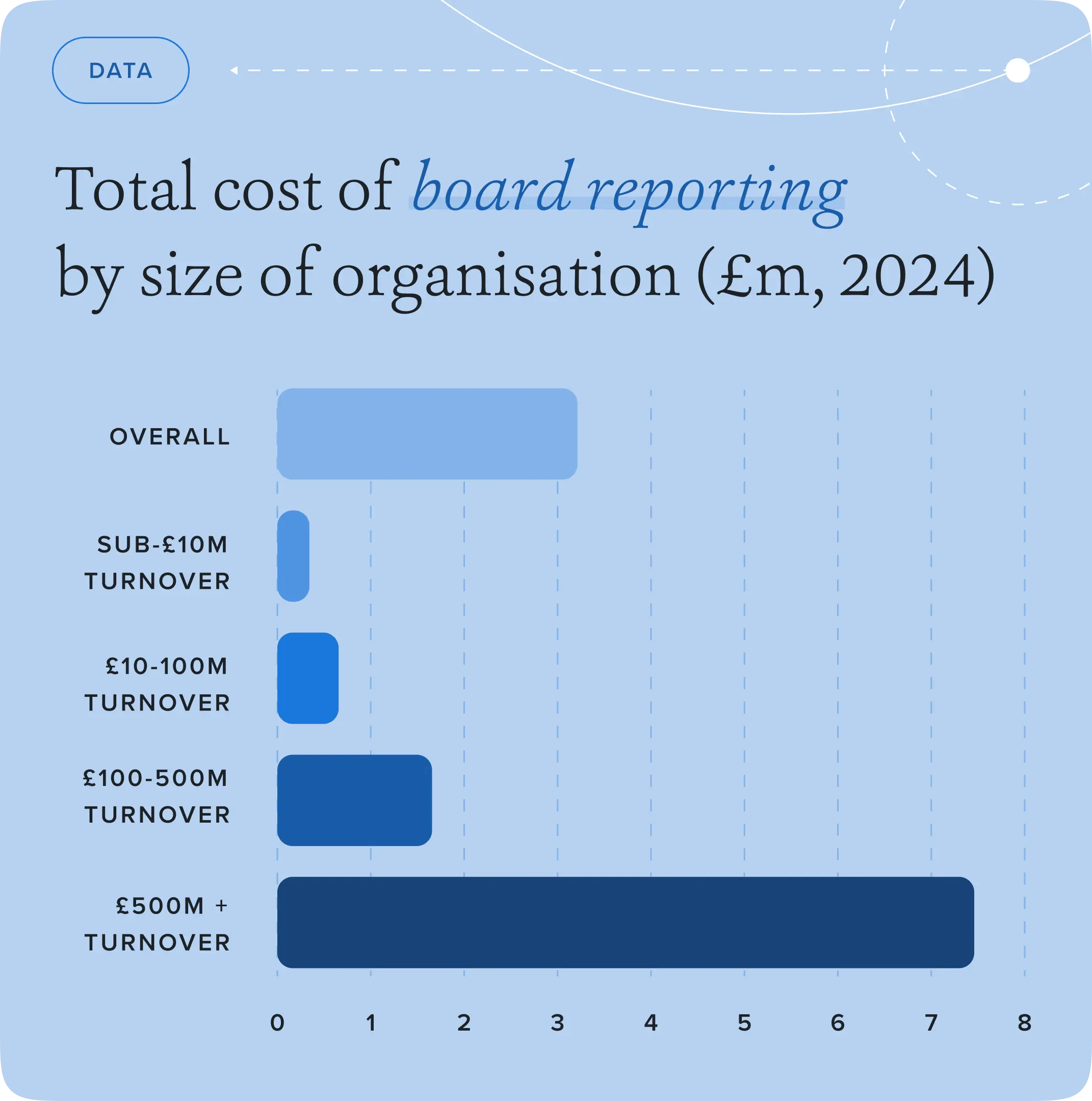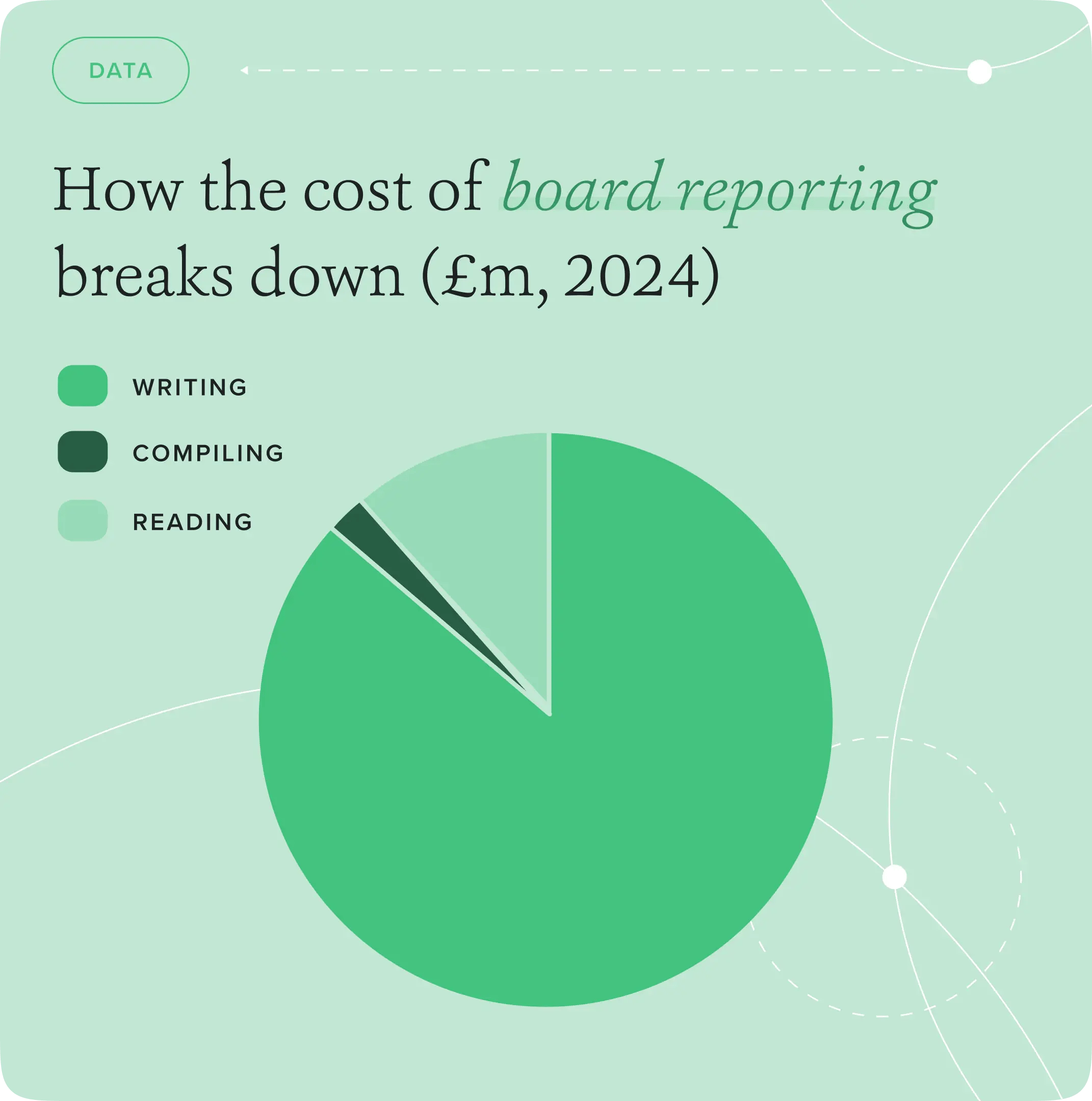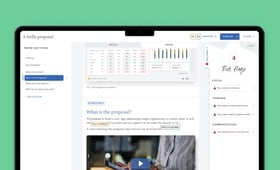Board reporting is expensive. But few organisations know exactly how much it's costing them.
Most finance teams can tell you what they spend on external auditors and legal advisers. But ask them about the cost of producing board papers, and you'll likely get a blank stare. That's because these costs are often hidden in plain sight — absorbed into salaries, buried in opportunity costs, and scattered across departments.
Board Intelligence and the Chartered Governance Institute UK & Ireland set out to quantify this hidden expense. Through extensive research with more than 800 organisations, we've built a model that reveals the true cost of board reporting. The findings are eye-opening. And they matter — because understanding what you're spending is the first step to understanding whether you're getting value back.
The board reporting value proposition
Before we talk about costs, let's be clear: board reporting isn't optional. It's essential for good governance, effective risk management, and regulatory compliance. More than that, when done well, it's hugely valuable for organisational performance.
The act of writing board papers gives busy executives a rare opportunity to step back from day-to-day operations and think about the big picture. It creates space for reflection — what's working, what's not, where the risks lie, where the opportunities are. It forces rigorous thinking about strategy and drives alignment across the leadership team. At its best, board reporting is a tool for clarity, focus, and action.
The problem? It's rarely done well.
Research we've conducted with the Chartered Governance Institute reveals that the challenges in board reporting are persistent, pervasive, and worsening. Papers are too long, too dense, and too focused on operational detail rather than strategic insight. They arrive too late for meaningful review. They don't answer the questions boards need answered.
When board reporting doesn't deliver value — when the process of writing papers doesn't create space for strategic thinking, and the papers themselves don't give boards what they need — the return on all that invested time plummets. You're paying the cost without getting the benefit.
Why board reporting is costly
One of the reasons board reporting is so expensive is that it consumes the time of relatively expensive employees.
For every board or committee meeting, C-suite executives, management, and subject matter experts are pulled into crunching data, writing drafts, and reviewing papers. Company secretaries coordinate briefs, manage submissions, and distribute board packs. The process ripples through the organisation, touching everyone from the chair of the board to junior analysts.
When you multiply those hours by the hourly rates of the people involved, the costs start to stack up. When a CEO spends three hours reviewing board papers, that's not free time, it's a direct cost to the organisation. When a CFO dedicates half a day to finalising a financial report, that's money. When multiple review cycles require input from five different stakeholders, each contributing an hour or two, those costs accumulate quickly.
Larger and more heavily regulated organisations face an additional burden: they typically produce longer board packs requiring input from a wider range of stakeholders and a greater proportion of complex papers (which require more extensive data gathering and review cycles).
The opportunity cost of board reporting
There's an additional cost of board reporting that's even more significant than the direct expense: opportunity cost.
When board reporting is done well — when the writing process creates space for strategic thinking and produces papers that drive better board decisions — this time is well spent. The value generated justifies the investment.
But when executives are caught in endless review cycles, battling with unwieldy documents, and producing papers that miss the mark, they're losing on two fronts. They're not getting the critical thinking benefit from the writing process. And they're not delivering the insight and clarity that boards need to make good decisions.
Every hour your CEO spends wordsmithing a poorly structured board paper is an hour they're not spending on strategy. Every afternoon your CFO devotes to the third or fourth review of a draft that still doesn't hit the mark is time they could invest in analysing market opportunities or meeting with investors.
This is the real hidden cost of board reporting: not just what you're spending, but what you're not gaining. Time that could be deployed on execution, innovation, and leadership is instead consumed by inefficient process and ineffective outputs. And the strategic value that good board reporting should generate simply isn't materialising.
What the data reveals
The board reporting cost calculator draws on published remuneration and employment cost data, and accounts for different roles, sectors, and organisation sizes, to reveal the monetary impact of board reporting.
Since 2019, we've gathered data from 837 directors, executives, and governance professionals using this tool. The picture that emerges is striking.
Costs are substantial and growing
In 2024, the average organisation spent £3.1 million on board reporting — equivalent to 3,580 working days. That breaks down to roughly £633 per page. For larger organisations with turnover above £500m, the annual cost reaches £7.3 million, consuming nearly 8,000 working days. Even the smallest organisations, those with under £10m turnover, spend £272,000 and 649 working days each year.
Since 2021, these costs have grown by 13% overall. The biggest rises? Lower-mid-market (£10m-£100m turnover) and small (sub-£10m) organisations, recording increases of 63% and 62% respectively.

Board packs are getting longer
The average board pack now runs to 228 pages — up 24% from 183 pages in 2019. Committee packs have grown even faster, increasing 33% to reach 128 pages. Small organisations have been hit hardest: those with under £10m turnover have seen their board packs balloon by 127% over the same period.
Writing dominates the cost breakdown
Writing board papers accounts for £2.7 million of the total cost, and more than 3,300 working days annually, for the average organisation. Reading board and committee packs consumes another £355,000 and 142 working days. Compiling the packs adds a further £53,000 and 85 working days.
These figures reveal a troubling picture: organisations are investing significant time and money in board reporting, yet research shows the quality and value of board papers continues to decline. The gap between cost and value is widening.

Improving your board reporting return on investment
The cost of board reporting won't disappear. Boards need information to make decisions, and that information has to come from somewhere. But organisations can dramatically improve their return on investment. Here's how.
Cut the time, improve the quality
This is where Report Writer changes the game. Built on 20 years of boardroom expertise and the QDI Principle, Report Writer transforms how organisations produce board papers.
Unlike generic AI tools, Report Writer is purpose-built for board reporting. It analyses your materials — whether management documents, recent reports, or rough notes — identifies key insights, selects the best structure, and generates a first draft in minutes. As you refine your paper, it provides real-time feedback on what's working, what's missing, and what needs attention. It's like having one of our consultants at your side.
The impact is tangible: faster initial drafts, fewer review cycles, consistent quality across all papers, and more time for strategic thinking rather than wordsmithing. For organisations spending millions on board reporting, that's not just efficiency — it's a fundamental shift in how senior time is deployed.
Learn more about Report Writer and hear what our clients have to say about it.
With Report Writer, you can go from blank page to ready-to-share paper in a blink, with the help of AI built on 20 years of report writing expertise.
See report writerSupport your people
Technology amplifies good practices, but organisations also benefit from investing in their people. Training report writers in effective report writing and data visualisation techniques, providing clear templates and guidelines, and establishing efficient briefing and review processes all contribute to better outcomes.
The end game
The goal isn't to eliminate board reporting — it's to make it more efficient and effective. Better papers take less time to write, less time to review, and less time for boards to read and digest. They provide better information, drive better discussions, and support better decisions. That's a return on investment worth pursuing.
Calculate your cost
Understanding the problem is the first step towards solving it. The board reporting cost calculator provides a straightforward way to estimate what your organisation spends on producing board papers.
The calculator takes minutes to complete and provides a data-driven estimate based on your organisation's characteristics. More importantly, it makes visible what has long been hidden — giving you a foundation for improving efficiency and effectiveness. You can also use our board pack assessment tool to identify specific strengths and weaknesses in your current approach.
Because when you know what something costs, you can start to ask whether you're getting value back. And if you're not, you now know exactly what to do about it.
Use our quick and easy board reporting cost calculator to uncover the hidden cost of creating and distributing your board pack.
Start now



